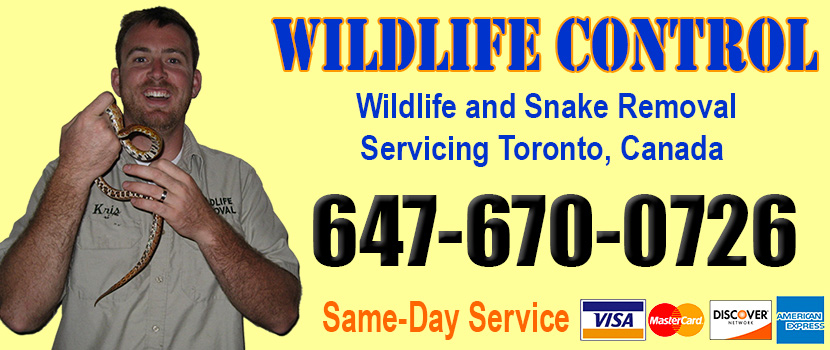
Welcome to torontosnakes.com! I am David, a snake enthusiast living in Toronto, CANADA. Many people don't know that Toronto is in fact full of snakes! You just need to know where to find them - they can often be shy and elusive. Some Canada snake species are more common outside of the city limits, in different parts of York County CANADA, but many types of snakes are indeed common in the more urban parts of Toronto. This guide is meant to help educate you about the beautiful snakes of Toronto, and to help you identify the most common snakes of Toronto, as well as the venomous snakes of Toronto that you should learn to recognize and avoid. If you want more detail, click here for my complete list of ALL snake species in Toronto. Remember the following:
- Most snakes of Toronto are harmless and don't want to encounter you
- Venomous snakes exist but are uncommon in Toronto, Canada
- Snakes eat rats and mice and are a valuable part of the Canada ecosystem
- Never kill a snake - if you leave a snake alone, it will leave you alone.
Common Snake Species in Toronto
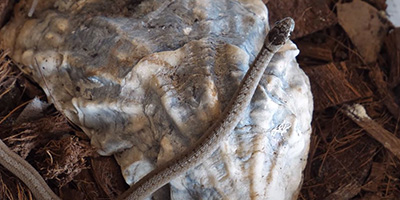 Dekay’s Brown Snake:
These snakes are relatively common in the area, and they can be found in a variety of places, such as prairies, wetlands, and forests. They also eat a variety of invertebrates and amphibians, but their diet mainly consists of slugs, worms, and small fishes. One can identify them through their brown or gray coloration with two rows of dark spots running along their back. They are also small, and they grow just about 19 inches in length. Because of their relatively small size and shy nature, little is known about this snake species.
Dekay’s Brown Snake:
These snakes are relatively common in the area, and they can be found in a variety of places, such as prairies, wetlands, and forests. They also eat a variety of invertebrates and amphibians, but their diet mainly consists of slugs, worms, and small fishes. One can identify them through their brown or gray coloration with two rows of dark spots running along their back. They are also small, and they grow just about 19 inches in length. Because of their relatively small size and shy nature, little is known about this snake species.
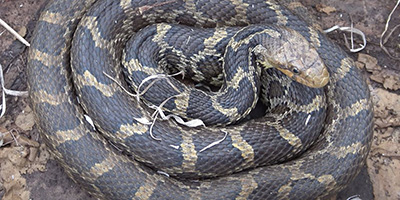 Eastern Fox snake:
The eastern fox snake can be identified through their rust-colored head, and a slightly yellow body with dark spots and they can also reach an average total body length of 3 ft to 5.5 feet or 66 inches. They can be found in areas such as tall grass prairies, wetlands, and rock barrens. They can climb trees well and are also excellent swimmers, which helps them hunt their prey. Their diet consists mainly of small mammals, frogs, birds, and bird eggs. Interestingly, they are nonvenomous, but when confronted, they will mimic a rattlesnake and vibrate their tail in hopes that they can fool their predators into leaving them in peace.
Eastern Fox snake:
The eastern fox snake can be identified through their rust-colored head, and a slightly yellow body with dark spots and they can also reach an average total body length of 3 ft to 5.5 feet or 66 inches. They can be found in areas such as tall grass prairies, wetlands, and rock barrens. They can climb trees well and are also excellent swimmers, which helps them hunt their prey. Their diet consists mainly of small mammals, frogs, birds, and bird eggs. Interestingly, they are nonvenomous, but when confronted, they will mimic a rattlesnake and vibrate their tail in hopes that they can fool their predators into leaving them in peace.
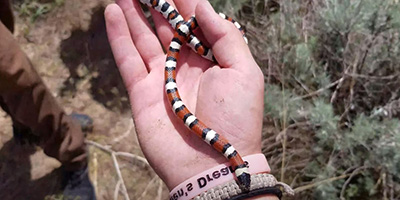 Milk snake:
Milk snakes have a distinct pattern that makes them easily recognizable. They would have a gray or tan background body color with red to red-brown spots that are bordered in black running along their back and sides. They also have a checkered black and white belly, with a Y or V-shaped mark on the back of their head. Milk snakes commonly exceed over 24 inches in total, with some growing over 39 inches long. They can usually be found in open areas such as fields, forest edges, and outcrops, and they can also be found around barns because they like to feed on mice. Other food preferences include birds and bird eggs, lizards, smaller snakes, fishes, and frogs.
Milk snake:
Milk snakes have a distinct pattern that makes them easily recognizable. They would have a gray or tan background body color with red to red-brown spots that are bordered in black running along their back and sides. They also have a checkered black and white belly, with a Y or V-shaped mark on the back of their head. Milk snakes commonly exceed over 24 inches in total, with some growing over 39 inches long. They can usually be found in open areas such as fields, forest edges, and outcrops, and they can also be found around barns because they like to feed on mice. Other food preferences include birds and bird eggs, lizards, smaller snakes, fishes, and frogs.
Venomous Snake Species in Toronto
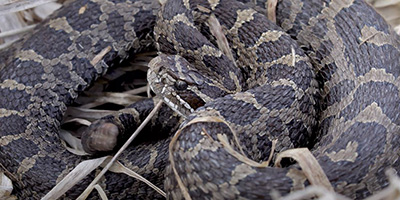 Massasauga Rattlesnake:
There is only one venomous snake in Toronto, and that is the eastern massasauga rattlesnake. They can be identified through their triangular heads and vertical, cat-like pupils. They also have butterfly-shaped spots and they have a rattle on the end of their tail. The average adult size is 18 to 40 inches in total length. Their name means “great river mouth” in Ojibwa, and as their name suggests, they are commonly seen in wetlands near rivers, and they also like tallgrass prairies, rocky barrens, and forests. They like to eat frogs and mice, but they also eat smaller snakes and voles. Massasauga rattlesnakes have heat-sensitive pits near their eyes, which enables them to see thermal images, like all pit vipers. This is also how they catch their prey.
Massasauga Rattlesnake:
There is only one venomous snake in Toronto, and that is the eastern massasauga rattlesnake. They can be identified through their triangular heads and vertical, cat-like pupils. They also have butterfly-shaped spots and they have a rattle on the end of their tail. The average adult size is 18 to 40 inches in total length. Their name means “great river mouth” in Ojibwa, and as their name suggests, they are commonly seen in wetlands near rivers, and they also like tallgrass prairies, rocky barrens, and forests. They like to eat frogs and mice, but they also eat smaller snakes and voles. Massasauga rattlesnakes have heat-sensitive pits near their eyes, which enables them to see thermal images, like all pit vipers. This is also how they catch their prey.
If you're unsure, you can email me a photo of the snake at info@torontosnakes.com and I will email you back with the snake's species. If you found a snake skin, read my Found a Skin? page, and you can email me a photo of the skin, and I'll identify the snake for you. If you need professional Toronto snake removal help, click my Get Help page, or see the below website sponsor I found, who provides that service.
Do I Need Protection To Handle A Snake?
Protection for Snake Handling
Snakes are dangerous creatures. Venomous or not, you have to acknowledge that they can and, likely will, bite you if you get too close. If you attempt to handle them, like when trying to remove them from your property, there is a high chance of them turning and biting you. They want to protect themselves and they want to be away from you. Biting is all they can do to protect themselves. When you handle them, they become overwhelmed with a sense of fear. They turn and bite the source of their discomfort and fear – you. Without proper protection and handling, you are going to come out of this hurt. Non-venomous snakes may not put your life at risk from a bite, but the bite remains painful nonetheless. It is not something you want to have happen to you.
Necessary Protection
The most necessary protection is gloves. You want large gloves that go up to your elbow, or just about there. Large, heavy-duty gloves will stop the bite from getting to you if the snake does turn on you. On top of that, you want to wear something long-sleeved. Long sleeves are another layer of protection between you and the snake. If the snake comes at you anywhere on your arm, where it is most likely to bite, it cannot get to you. Make sure that the gloves and sleeves of choice can handle a snake bite. Anything too thin will not do much protecting. As the snake can still bite through them easily, you want something a bit more heavy duty. Though any material will add an extra layer, you want to give yourself the lowest risk of a bite going through.
When Handling
Sleeves and gloves are a good first step, but they are not the only pieces of protecting yourself. You want to know how to handle the snake, as well. Many professionals will hold the snake by the head, making it difficult for the snake to bite or do anything. If you know what you are doing, this is a great way of handling the snake. A firm grip keeps you safe without hurting the snake. When you grab the snake by the tail, though, there is a risk of it biting you. This is why you need sleeves. It will throw itself at whatever it can to get away. Keep your arm stretched out and away from your face and body so it cannot reach you anywhere but your arm. Handling snakes can be dangerous. Limit the risks to you by wearing the proper protective gear and knowing how to handle the snake.
Remember, the term is not poisonous snakes of Toronto, it's venomous snakes of Toronto. Poison is generally something you eat, and venom is injected into you. That said, dangerous snakes are very rare in Toronto. The few venomous snakes of York County are rarely seen. But they are commonly misidentified, so learn about all the snake species of Toronto in order to correctly identify them. These snakes are usually also found in the surrounding towns of Toronto, Ottawa, Hamilton, London, Windsor, Mississauga, Kitchener, Peterborough, Great Sudbury, Guelph, Niagra Falls, Brampton, Oshawsa, Thunder Bay, and the surrounding areas.
Read our article about:
Do Snakes Have Ears? Can They Hear?
torontosnakes.com domain and hosting costs made possible by the generous support of this sponsor:
